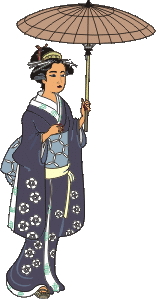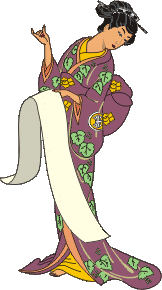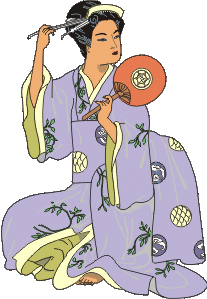 Described as a "century old professional entertainer" the geisha is an important part of traditional Japanese social life. Usually circulating their services in the higher classes exclusively, these woman are extensively trained in many of the traditional Japanese arts. Her grace is exceptional, her charm, exquisite. These woman are professional hostesses in an exotic variation.
Geisha GeishaThe earliest geishas were men, but by the 18th century women dominated the trade. Young girls may start training before reaching puberty. At age 17 they begin living in a maiko house young novice geishas called learn the arts needful to their trade. Only women who are at the top of their group and pass a rigorous exam actually become geisha.
Described as a "century old professional entertainer" the geisha is an important part of traditional Japanese social life. Usually circulating their services in the higher classes exclusively, these woman are extensively trained in many of the traditional Japanese arts. Her grace is exceptional, her charm, exquisite. These woman are professional hostesses in an exotic variation.
Geisha GeishaThe earliest geishas were men, but by the 18th century women dominated the trade. Young girls may start training before reaching puberty. At age 17 they begin living in a maiko house young novice geishas called learn the arts needful to their trade. Only women who are at the top of their group and pass a rigorous exam actually become geisha.
 Literary translated, geisha means "Beauty Person" or "Person who lives by the arts", and that they do. Geisha are masters in the arts; trained in music, calligraphy, Sado (tea ceremony) poetry, conversation and social graces as well as a three stringed instrument called a Shamisen. They dress in traditional kimonos, gorgeous in their elegance. Simple wooden geta clogs are worn for footwear, and hair is up in coiffures adorned with metallic accessories. The makeup of centuries is a white foundation, lips are painted a stark red. For the younger girl, only the upper lip is painted. For extra sensual appeal, a red streak is painted at the nape of the neck, for the more neck you show, the more risque your costume.
Literary translated, geisha means "Beauty Person" or "Person who lives by the arts", and that they do. Geisha are masters in the arts; trained in music, calligraphy, Sado (tea ceremony) poetry, conversation and social graces as well as a three stringed instrument called a Shamisen. They dress in traditional kimonos, gorgeous in their elegance. Simple wooden geta clogs are worn for footwear, and hair is up in coiffures adorned with metallic accessories. The makeup of centuries is a white foundation, lips are painted a stark red. For the younger girl, only the upper lip is painted. For extra sensual appeal, a red streak is painted at the nape of the neck, for the more neck you show, the more risque your costume. Within Tea Houses, the geisha organize themselves hierarchically with relationships based on the family model (i.e. mother/daughter younger/older sisters). Within each tea house is a "mother" who is in charge of the conduct and class of all her geishas contained therein. Also, each geisha has a senior elder sister who helps in her continuous training. In this way the traditional knowledge can be carried on.
Within Tea Houses, the geisha organize themselves hierarchically with relationships based on the family model (i.e. mother/daughter younger/older sisters). Within each tea house is a "mother" who is in charge of the conduct and class of all her geishas contained therein. Also, each geisha has a senior elder sister who helps in her continuous training. In this way the traditional knowledge can be carried on. Once the geisha were the trend setters of fashion and taste, now with Japan's modernizing their role has been less prevalent. During the 1940s, geisha entertainment was outlawed and many were forced into factory and industry labor. The late 1970s saw geisha numbers drop to around 17,000. Today they number fewer than a thousand found mostly in Osaka and Kyoto. Many Japanese businessmen find the company of modern hostesses and barmaids much more comfortable. While those who would appreciate fully the artistry of her talents are long gone, her honor to uphold the customs will remain as long as there are Geisha to serve and learn these ancient arts.
Once the geisha were the trend setters of fashion and taste, now with Japan's modernizing their role has been less prevalent. During the 1940s, geisha entertainment was outlawed and many were forced into factory and industry labor. The late 1970s saw geisha numbers drop to around 17,000. Today they number fewer than a thousand found mostly in Osaka and Kyoto. Many Japanese businessmen find the company of modern hostesses and barmaids much more comfortable. While those who would appreciate fully the artistry of her talents are long gone, her honor to uphold the customs will remain as long as there are Geisha to serve and learn these ancient arts.
 Go to our Geisha Pictures Gallery
Go to our Geisha Pictures Gallery 
Some good Geisha links :
The Story of Kiharu Nakamura.
'Memoirs of a Geisha'.
A Picture Tour of Japan.
Geisha's Garden.
Some Geisha fun-stuff :
Geisha make-up.
Buy kimono on-line.
Download a Geisha-desktop.
Oyama Dolls.
Adopt a virtual Geisha.